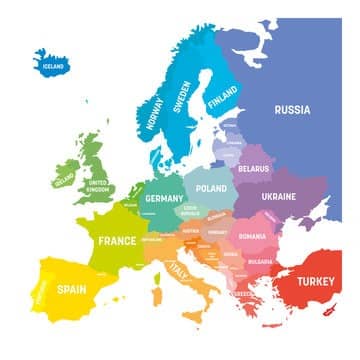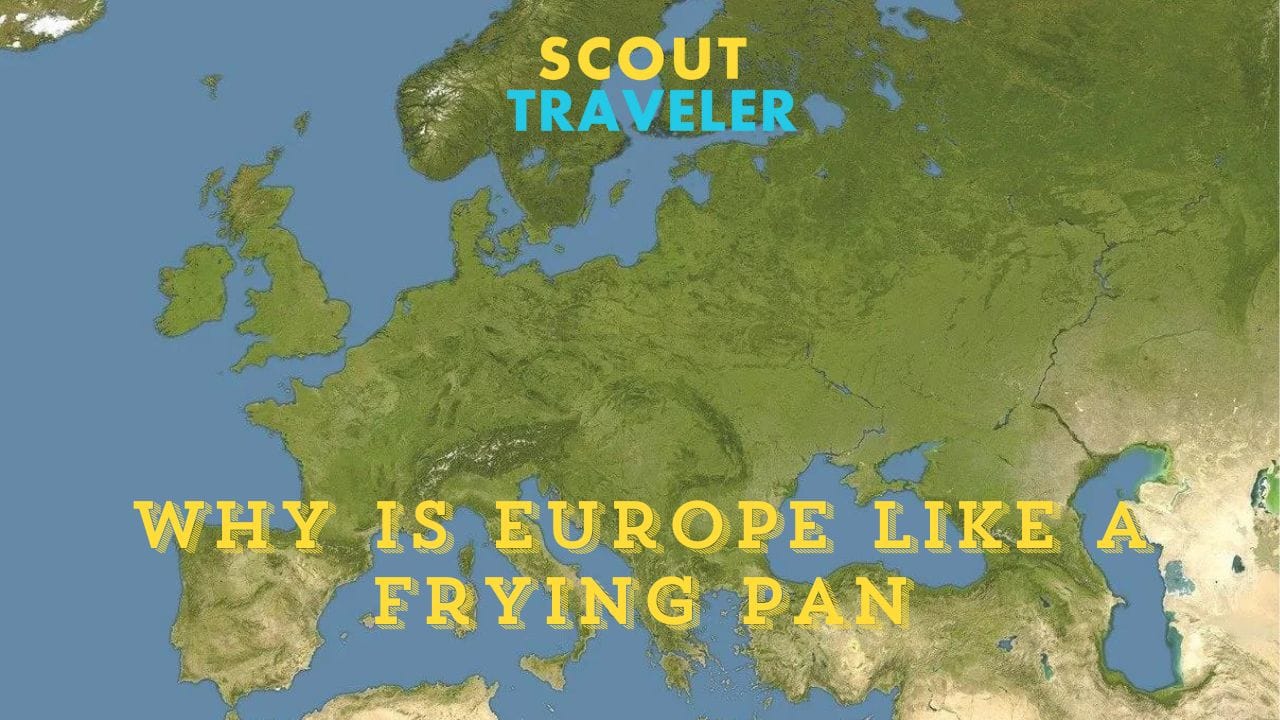This article explores the reasons behind why is Europe like a Frying pan. Well you might be surprised after knowing the fact about the resemblance of Europe with the frying pan. Let’s dive into why is Europe like a Frying pan.
Why Is Europe Like a Frying Pan

Europe is humorously compared to a frying pan due to its shape when you draw and outline of Europe countries on maps; this comparison is more of a jest.
This playful comparison highlights its unique geography. Europe continent true essence lies in its historical and cultural diversity, making it more like a tourist pot than a frying pan.
Why Is Europe So Beautiful
Europe’s beauty is unparalleled, with a blend of natural wonders and architectural marvels. From the snowy peaks of the Alps to the sun-drenched beaches of the Mediterranean, Europe’s landscapes are incredibly diverse.
Europe’s cultural heritage is equally impressive. The continent is home to a rich history of art, music, and literature. Visitors can explore centuries-old cathedrals, castles, and museums that house works by legendary artists such as Leonardo da Vinci, Michelangelo, and Van Gogh.
The unique charm of Europe’s villages, with their cobblestone streets and quaint houses, adds to the continent’s allure.
Europe offers a variety of outdoor activities. From skiing in the Swiss Alps to hiking in the Scottish Highlands, there is something for every nature lover. The continent’s diverse climates support a wide range of flora and fauna, making it a paradise for nature enthusiasts.
Best Places to visit in Europe
| Country | Attraction | Description |
| Italy | Amalfi Coast | Stunning coastline with cliffs and beaches |
| France | Eiffel Tower | Iconic landmark in Paris |
| Greece | Santorini | Picturesque island with white-washed buildings |
| Switzerland | Swiss Alps | Majestic mountains perfect for skiing |
| Spain | Alhambra | Historic palace and fortress in Granada |
Best Time to Visit Europe
Choosing the best time to visit Europe depends on what you want to experience. Each season offers something unique:
Spring (March to May)
Spring is an excellent time to visit Europe as the weather is mild, and the landscapes are blooming with flowers. Popular destinations like Paris and Amsterdam are less crowded, and you can enjoy outdoor activities without the summer heat.
Summer (June to August)
Despite from the large numbers of waterfalls in Europe, summer is the peak tourist season in Europe except the Southern Europe. The weather is warm, often feeling like a frying pan. Summer is the best time to visit coastal areas, enjoy festivals, and explore cities like Barcelona, Rome, and Athens. However, be prepared for larger crowds and higher prices.
Autumn (September to November)
Autumn offers a pleasant climate with fewer tourists. The fall foliage in countries like Germany and Austria is breathtaking. This season is ideal for cultural tours and wine tasting in regions like Tuscany and Bordeaux.
Winter (December to February)
Winter is perfect for those who enjoy winter sports or want to experience Europe’s festive season. Cities like Vienna and Prague have enchanting Christmas markets, and the Alps are perfect for skiing. However, northern Europe can be quite cold, so pack accordingly.
Is Europe an Affordable Travel Destination for All Budgets?
Europe is a diverse continent with options for every budget. Whether you’re a backpacker or looking for luxury, Europe has something to offer.
Budget Travel
For budget travelers, Europe offers a range of affordable accommodation options such as hostels, budget hotels, and Airbnb. Public transportation is extensive and often cost-effective, with options like Eurail passes for train travel. Many cities also offer free walking tours, and you can find affordable street food and budget-friendly restaurants.
Mid-Range Travel
For those with a moderate budget, Europe provides a comfortable travel experience with mid-range hotels and guesthouses. You can enjoy a variety of culinary experiences, from local bistros to mid-range restaurants. Renting a car can be a great way to explore the countryside and smaller towns.
Luxury Travel
Europe is a haven for luxury travelers, with five-star hotels, gourmet dining, and exclusive experiences. Cities like Paris, London, and Milan offer high-end shopping, while the French Riviera and the Amalfi Coast are perfect for a lavish beach vacation. Private tours and exclusive events add to the luxury experience.
Budget Travel Tips for Europe
- Stay in hostels or budget hotels
- Use public transportation
- Eat at local street food
- Take advantage of free walking tours
- Travel during the off-peak season
Final Thoughts on Why Is Europe Like a Frying Pan?
Europe is humorously compared to a frying pan because of its shape on the map. If you leave out Scandinavia and flatten it a bit, it looks like a frying pan. Spain and Portugal forms the handle of the pan, while the Balkans and Italy shape the base. This comparison is just for fun. Europe is much more than its shape. Its real charm comes from its rich history and diverse cultures
FAQS on Why Is Europe like a Frying Pan
Why does Europe look like a frying pan?
Europe looks like a frying pan on maps, especially if you exclude Scandinavia and flatten from the map. The Spain and Portugal forms the handle, and the Balkans and Italy make up the base.
Which country is most famous for cooking?
France is the most famous country for cooking, known for its culinary traditions, fine dining, and renowned chefs.
What is the prettiest city in Europe?
Paris, France, is the prettiest city in Europe which is famous for its stunning architecture, romantic ambiance, and iconic landmarks.
What is Europe most known for?
Europe is famous for its abundant history, diverse traditions, and picturesque scenery. Its shape is compared to a frying pan which is just a joke.
What is the oldest frying pan in the world?
The oldest frying pan in the world takes us back to the ancient Greece, around the 5th century BC, and was made of ceramic.
